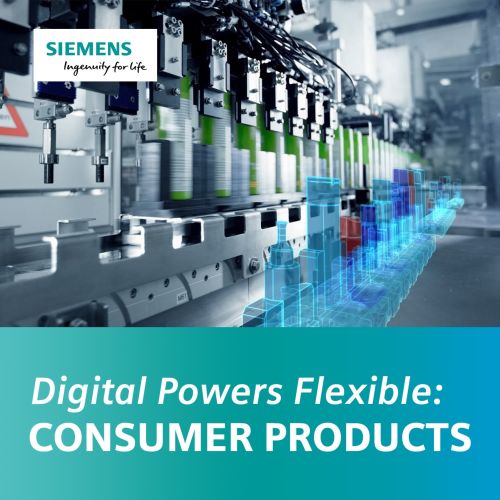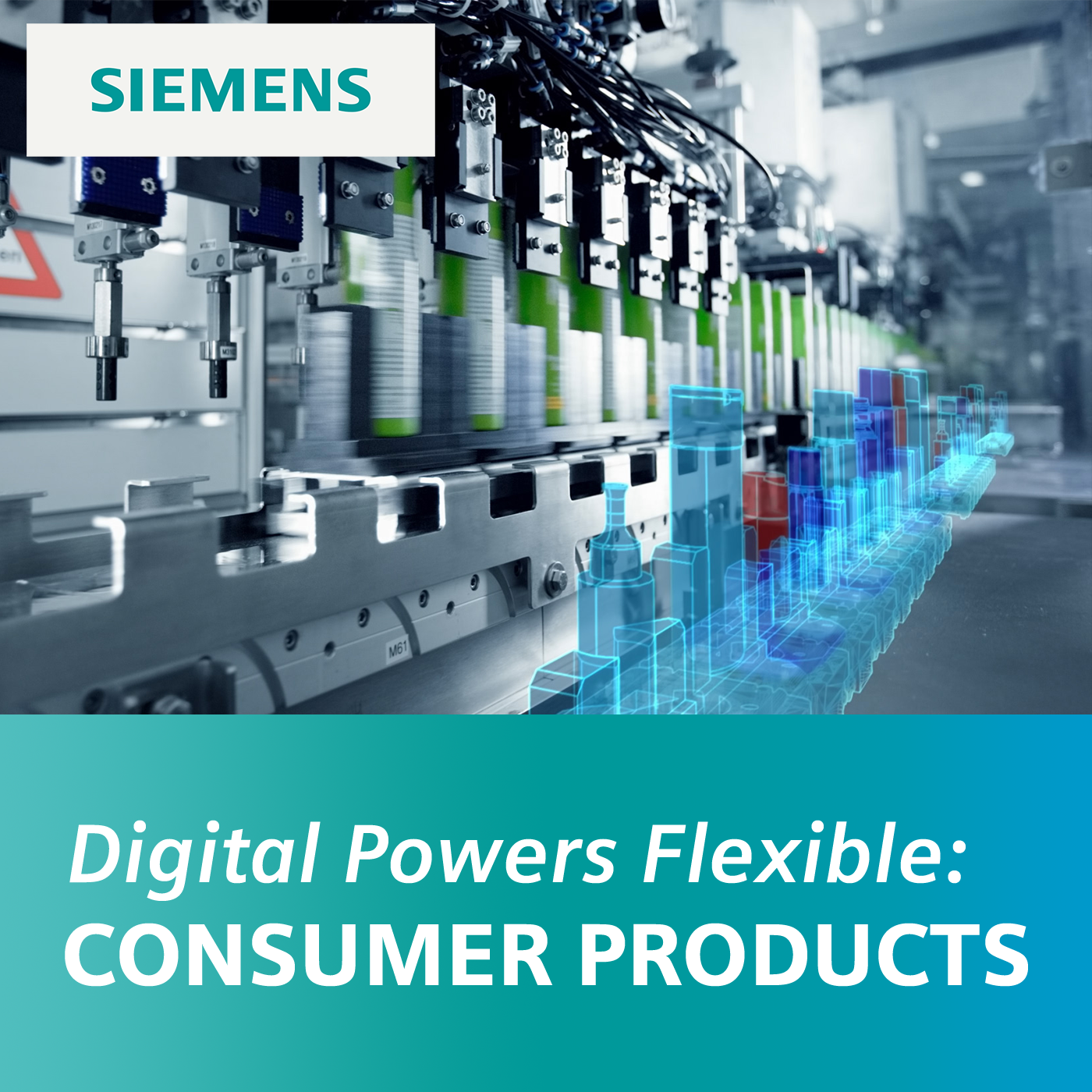Consumer Products Podcast – Efficiency and Sustainability Benefits of Digitalization (Ep. 2)

In the first episode of the Digital Powers Flexible podcast, our experts examined the struggle to adapt the consumer product industry to an ever-changing marketplace, how digitalization helps businesses grow and much more. In this episode, Suzanne Kopcha and Alastair Orchard return to discuss some of the solutions and technologies that cater to the growing demand for individualized and sustainable products.
Steve Hartman: In the first episode of “Digital Powers Flexible,” we took a glimpse into the consumer products industry’s struggles to adapt to an ever-changing marketplace, how digitalization has the ability to help businesses within the consumer products industry grow and how Siemens grew to become one of the leaders in digitalization.
Just like on our previous episode, I’m joined with Suzanne Kopcha – who is responsible for industry strategy for consumer products; before joining Siemens – and Alastair Orchard, who has been at Siemens now for almost 20 years and was one of the first people who defined the company’s so-called ‘Digital Enterprise Portfolio.’ And I’m Steve Hartman with the branding and communications team.
Now it’s time to discuss some solutions and technologies which cater towards the market’s need to create individual and sustainable solutions.
My first question here is for Alastair.
So, we’ve talked about digitalization, and we’ve talked about consumer products. How does digitalization unlock the solutions to these challenges that consumer product manufacturers face?
Alastair Orchard: I like to think about digitalization, literally, as being this virtual reflection on a real world. And so, we treat that question literally by looking at the processes that typically occur in the real world, and then finding a digital analog for those. The first thing that we need to do as an organization that is digitally transformed and that is trying to get closer to customers is literally, listen to the customer, interpret their requirements, and turn them into a series of design directives. This is something you cannot do for an entire market of thousands of people spread throughout the world unless you use digital technologies. So, here is social media, the internet portals for customers – these are all ways of channeling either individual sets of requirements or understanding and interpreting market trends and bringing them into a common or well-defined set of characteristics for a product that our organization can then work on, in order to develop a product that’s going to meet those requirements. So, that’s the first stage: how to use digital technologies as a portal, as an outreach mechanism, to listen, to engage and interpret the requirements of customers.
The second one is what not to do with that. Now I have potentially hundreds or thousands of requests that I’ve interpreted. Do I have hundreds or thousands of designers? No. And so, this is where we bring really the power of computers to bear. So, what you have to do is forget this idea of a designer pushing a mouse around on a screen in order to design a digital product. We now use computer algorithms to do that far, far more efficiently. And this is what really unlocks the possibility of achieving thousands of individual designs in the same time that a design was made manually in the past. So, how does that generative design algorithm work? It works using goals and constraints.
Suzanne Kopcha: You know, as Al was talking, one of the things that came to mind about generative design is sitting in front of a customer and we were talking about what generative design is, and it was a great moment because they just stopped and looked at me and said, “Suzanne, wait a minute! Is this really CAD plus integrated simulation, plus, what I’ll call machine learning and AI to help me get better designs faster and look really good? I can’t even do that because some of the technologies are so complicated. You put them all into this really cool thing you call ‘Generative Design’?” And I just smiled and looked at him and said, “Absolutely! That’s what we’re all about: bringing cool technologies that help you to do today what you manually can’t do. And the role of a digital twin is not just a model of what you can do manually, but it’s a digital representation that, combined with other technologies, helps bring the brilliance of your mastery to life in a way that you just can’t achieve manually.” So, it was a really cool customer moment. And watching this customer’s eyes light up, made me really proud of what the capability can do for that designer sitting there, trying to do the best job that they can for their company.
Steve Hartman: With generative design, there’s a certain sustainability factor in that, as well, because you’re potentially using less material?
Alastair Orchard: I love this question! We often get challenged with digitalization whether or not we are promoting a behavior within a company, which is actually moving in the wrong direction in terms of sustainability and it’s absolutely not true. Imagine that if my factories are making a million of the same thing, then somehow they’re more efficient than if I’m making a million of individual things – and it’s really not true. I gave the example before about our 13x increase in efficiency in our Amberg factory – this is absolutely replicable, even when making individualized products. And there’s a number of factors there.
The first one has got nothing to do with design, per se. It’s just that, if I’m designing individual products for individual consumers, then I’m going to sell all of them. So I’m not making to stock, I’m not making hundreds of thousands or millions of shoes 18 months before they hit the shelves halfway around the world, hoping that they’re going to be a success. I’m never going to get that right; I’m either going to make too few and leave disappointed consumers and leave profit on the table, or I’m going to make far too many and that is a waste of resources. So that’s the first factor.
The second factor, as you mentioned, my designs are now optimal in terms of material usage so, I can decide to minimize plastics and other types of material that are non-sustainable, and I can ensure that my designs use as little material as possible. So, the fact that these look organic is because they’ve been designed to remove from the design of all superfluous materials. The third factor is that I can put manufacturability goals in my design algorithm, which means that when I finally get to produce this product, it’s going to use as few resources, as little energy, produce as little CO2 as humanly possible. So, there’s your third sustainability factor.
And the final one, I would say, is that very often these products aren’t going to be manufactured using traditional techniques. So, specifically, generative design algorithms tend to create shapes, which are best manufactured using additive manufacturing – that’s 3D printing – and the beauty of that value chain is that you can put a 3D printer right next to your consumer. And so, instead of shipping large quantities of material and generating Co2, you’re just shipping digital files over the internet and printing locally. So, this is a highly sustainable process and it’s one of the most important benefits to the society of digitalization.
Steve Hartman: Let’s take individuality and sustainability even further and let’s say there’s a shaving package, which includes a razor with an ergonomic handle, my choice of three or four blades. The package includes a shaving foam, and I want a lavender scent. And of course, the package itself has to have my name on it. Oh, and also I want these products to be sustainably produced. How can a digitized process enable all of this?
Alastair Orchard: You want it lavender flavored?
Steve Hartman: Well, what can I say? My wife likes lavender scent.
Alastair Orchard: So, in order to answer your question, we’re going to have to open up the question of design once more, very briefly; we’re going to have to look inside the digital twin of the product one more time. And the reason we do that is that, once my product is designed and its future performance predicted and validated in the virtual world, I do not close my design out because I still have one important question to answer and that is, “Can I make it?” So the question of manufacturability is a really critical question that involves the R&D and design department. Now, traditionally, that question can only be answered by closing out the design, throwing the design over the wall into manufacturing, and asking the factories to give it a go and see if this design can be manufactured. This is incredibly wasteful in terms of time, in terms of resources, and it’s surely not compatible with any personalization goal or request to make an individualized product.
Steve Hartman: So, what are the options for a manufacturer to know what it takes to manufacture that product and then know the most efficient way?
Alastair Orchard: We’re going to keep our digital twin of the product open for a moment and we’re going to begin collaborating with manufacturing in the virtual world. In order to do that, we have to leverage another digital twin – it’s what we call ‘Digital Twin of Production’, and here it’s a very similar concept but instead of representing the product digitally, we’re now representing our manufacturing capacity digitally. It’s almost hard to believe, but we literally, in our factories and in our customers’ factories, we create a digital model of that entire manufacturing facility or the people and those people – we can even scan in the people – so we’ve got tall people and not-so-tall people – and every shift is characteristic of the different people that you’ll find on the shift. We represent all of the machines with their capabilities, robots with their end effectors and their highly flexible manufacturing capabilities, logistics processes And, before we close out the design of the product, we ask our designers to give that product to the virtual factory in order to see if it’s manufacturable. We use generative design again, to allow all of those manufacturing resources to get their hands on that design and work out the best way of making first each individual element and then the overall assembly. If we find areas of difficulty in manufacturing that could be improved by tweaking the design, that’s exactly what we do. So, this is a closed-loop iterative process – our generative algorithm is going to adjust the design by iterating one or two more times in order to resolve those manufacturing issues, and finally, our design is going to be closed out.
Now, the digital twin of production is also highly flexible. So, it’s extremely unlikely that this new product design can just be made inside the factory without adjustments to the way the factory operates. And here, we really have to think on two levels. So, the first level is back down to those individual parts – are my machines capable of performing exactly the combination of movements and operations And if the answer is no, then we will generate new automation code in the virtual world, we’ll test it using the digital twins of production of those products, and then we will push that new automation code out along the digital thread into the machine on the factory floor so that the machine has now received a new capability.
We do the same thing for people. So, we simulate the operations that we’re going to ask the people to do, we make sure that they’re safe, we make sure that they’re ergonomically perfect to avoid injury or fatigue, and to maximize efficiency and comfort, and we generate electronic work instructions, which we push out onto the shop floor. The same for robots. We need to ensure that they are capable of performing all of the movements required to assemble a particular product. So now, every resource in my factory has tried a thousand times to make this product. It is refined in the virtual world, the exact movements and sequences that it needs to do in order to do it efficiently. The real resources required have been generated and tested and it’s been through what’s called virtual commissioning – that’s pushing that code out onto the shop floor, making it ready for the arrival of the order, which will signify the beginning of manufacturing of that piece.
The second level is related to the journey that this product has to take through the factory in order to match itself up with all of these manufacturing resources. Most factories today are set up with completely fixed manufacturing routes and this is what renders them inflexible, this is what makes them capable of only making one type of product at a time. But, by liberating the production logistics within a factory, by allowing each route that a product takes to be optimized in the virtual world and then executed individually on the shop floor, suddenly, our factory has gone from making millions of one thing to making an eclectic mixture of products.
So, back to your question, Steve, this combination of products that’s been made in my factory, now, each one of those parts has to make its way. This is a highly autonomous concept – they need to find their way to the packaging line. And then, we use artificial intelligence to render the packaging of this never-before package combination possible. So our robotic packaging actually uses vision systems and AI – so, the robot looks around for the parts which are a part of your order, it identifies them, picks them up, rotates them, places them the right way up inside the packaging; maybe a companion robot will put a spot of glue there on the package so that the lavender shaving foam doesn’t rotate – no one wants to open a present and find that the can with your name on has rotated in transit. All of these things have to be considered. The package is closed. An individual marker is placed on that package, and that individual marker becomes an anchor between this physical package and the digital twin of this product in the virtual world, and you’re going to be using that anchor later on in order to look at the journey of this product and validate those claims.
Suzanne mentioned this at the beginning. You were looking for a sustainable product. Well, how much CO2 is actually used during production? You were looking for a product that was rain forest friendly. Well, can you prove that that was rainforest friendly? Can you prove that it’s a vegan product? Can you prove that it was manufactured locally? Can you show me the certifications which go along with those claims? And that’s all done through this special serialized marker that ties up to a companion app which you can download from the internet. That product is then shipped directly to you avoiding, wherever possible, unnecessary transport, storage, all of which are damaging to the environment.
Steve Hartman: Hopefully some consumer products manufacturers are listening to this. Suzanne, how do you work with these companies so they can adopt these digital solutions to their best advantage?
Suzanne Kopcha: I think the challenge that we have is a lot of companies and consumer products are just getting started, and when we communicate our digital enterprise, it can seem pretty complex to them, even though Alastair can so easily talk through it and all of the amazing capabilities that we have. one of the things that we’ve done is we’ve looked at the intersection of those digital twins and the compilation of that digital enterprise, and we’ve broken it up into what we call ‘Industry Solutions’ or ‘Digital Threads’, it’s that peel the onion and let’s look at the next layer of capability that breaks it up and makes it digestible for different parts of an organization with solution sets that help solve the problems that they’re dealing with every day, the problems that strategic customers are telling us are the ones that they need to solve. So I think it could be really valuable to take a step back and step through the story that Alastair just told us and talk about each of those threads. There’s actually two more – I call them ‘The Bookend Threads’ – at the beginning and the end of the design and manufacturing process that become critical to our whole story.
Steve Hartman: Thank you, Alastair, for the in-depth break down of the digital twin in regards to its capabilities for process, production and performance. And thank you, Suzanne for explaining why companies are going at this slowly and why adoption is critical.
In our next podcast, we’ll continue the conversation by deep-diving into each of these digital threads and how they help companies with varying portfolios stay ahead in the ultra-competitive marketplace.
Thanks for listening to episode two of the Digital Powers Flexible podcast.
Designing and manufacturing individualized products takes large amounts of input from consumers. Social media is a great way to provide direct access to their requirements and overall market trends for new products. But designing the products to meet individual customer requirements, even a fraction of them, would require far too many designers and time. Instead, using generative design, hundreds or thousands of products can be designed without drastically increasing staffing. The generative design algorithm produces the thousands of possible design directions based on product goals and restraints.
Generative design is one of many powerful tools that make a comprehensive digital twin. The digital twin is a digital representation that, combined with other technologies, helps bring the brilliance of your mastery to life in a way that you just can’t achieve manually.
Along with a strengthened connection to customer demands, design and simulation software offers multiple efficiency and sustainability improvements to consumer product design:
- The first benefit is creating an intrinsic relationship between supply and demand for individualized products. If you are designing and producing individual products for an individual consumer you are going to sell all units. This means less over-stock and stagnant investment.
- The second is the optimization of material use. Generative design can focus on using the least amount of material possible while still meeting the product requirements.
- The third improvement is the inclusion of manufacturability goals in the design algorithm. This can be utilized to minimize manufacturing resources and the energy needed per unit as well as minimize CO2 production.
- The fourth will come with the ubiquity of additive manufacturing. Additive manufacturing can be done almost anywhere, so why not send a digital file of the product to a customer’s region and manufacture the product locally? This would greatly reduce emissions from transportation as large quantities are not being shipped from a single location, requiring less fuel and generating less CO2.
When it comes to the manufacturability of a product, it is now possible to leverage another digital twin the digital twin of production. Here, software represents the manufacturing process, including the people working in the factory. Using the digital twin of production, consumer product manufacturers can ensure the machines perform the desired operations, while ensuring the maximum safety, efficiency and comfort of the workers.
The digital transformation described in this podcast brings together many advanced technologies and solutions to provide a more actionable customer relationship and a reduced up-front investment in a diversified product portfolio, all the while increasing efficiency during the design phase and in the production process.
Listen to the podcast to hear about other aspects of the digital transformation, from flexible production lines and automated guided vehicles to intelligent packing robots. Our experts even look at complete product traceability from raw materials to delivery to the customer.

Suzanne Kopcha – Speaker
Suzanne has been a part of Siemens for over five years and is responsible for industry strategy for consumer products; before joining Siemens, she spent 25 years at Procter & Gamble.

Alastair Orchard – Speaker
Alastair runs the Digital Enterprise Thought Leadership team for Siemens Digital Industries, working with multinationals to become more flexible, cost effective, transparent, collaborative organizations, and to bring their world-class products to market faster than their competitors.

Steve Hartman – Host
Steve has been at Siemens for over two years and is responsible for writing various content as well as producing videos and podcasts.

Digital Powers Flexible
Digital Powers Flexible: Consumer Products is a podcast brought to you by Siemens Digital Industry Software.
